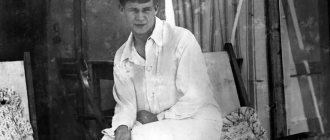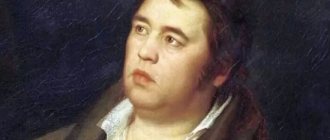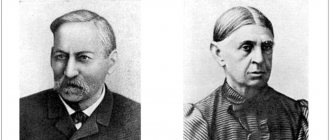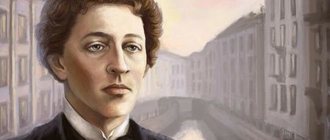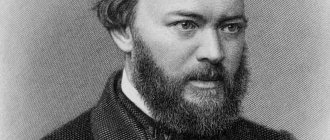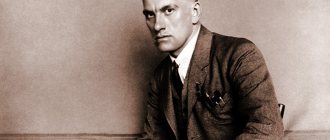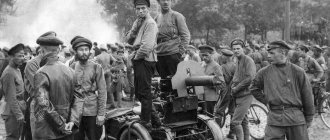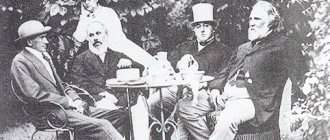- Essays
- Famous people
- Chronological table of Mayakovsky's life and work
On July 19, 1893, the Russian poet Vladimir Vladimirovich Mayakovsky was born in Georgia. In the family of Vladimir Konstantinovich and Alexandra Alekseevna Pavlenko. The couple had five children: two daughters and three sons, but two of them died in childhood.
1902 - begins his studies at the gymnasium, where he additionally studied drawing. At his young age, he found himself at the epicenter of the first wave of the revolution that reached Georgia. The poet participated in rallies, read brochures that were published for propaganda purposes.
1906 - a misfortune occurs in the family, the father dies. The cause of death was infection from a needle while he was stitching papers. This incident greatly influenced the writer, and he began to obsessively monitor hygiene, constantly washing his hands and carrying a collapsible basin and soap with him. I also took cologne with me, which I used to disinfect everything possible.
1909-1910 served 11 months in prison because he joined the Bolshevik Party, then he worked in underground printing houses. After prison he entered the Moscow School of Painting, Sculpture and Architecture. At the school he met some guys, together they created the group “A Slap in the Face of Public Taste”, which went against the system of the usual understanding of creativity.
1913 — Mayakovsky tries himself as an actor in the theater, where he organized the script and production himself. Later he became interested in cinema, wrote scripts and even starred in one film.
1915 — meet Lilya Brik and her husband Osip. Mayakovsky falls in love with her at first sight, even dedicated many of his poems and poems to her, where he confessed his love to her.
1919 - the poet joined the “Windows of ROSTA”, which included various poets and artists. They chose sensitive topics on which they produced propaganda posters, some call them the first social advertising.
1922 — Mayakovsky founded the group “Left Front of the Arts”; later they founded a magazine with the same name. The magazine included publications of poems and prose, avant-garde photographs, bold projects by architects, as well as news in the world of non-standard art.
1925 - Having finally broken off relations with Lilya Brik, the poet goes on tour to France, Spain, Cuba and the USA. In America, meet a Russian emigrant who works as a translator, Ellie Jones. They began a whirlwind romance, albeit quite short. Upon returning home, he learned that he had a daughter, Ellen-Patricia.
1928-1929 - wrote the satirical plays “The Bedbug” and “Bathhouse”, which were staged in theatrical productions.
The assessment of the plays was twofold: some saw in them only humor and satire, while others saw criticism of the Soviet system. One of the plays was performed only a couple of times, and then was banned altogether.
April 14, 1930 - Mayakovsky dies
Chronological table
Years of Mayakovsky's life 1893-1930. A lot of interesting events happened to him.
Conventionally, the periods of his life and work can be divided into two stages:
- Pre-revolutionary.
- Soviet.
When the poet died, the government banned all of his works. It was only possible to remove it several years later.
The poet's works were even more appreciated after his death. The chronological table of Mayakovsky’s life and work allows you to learn about the most striking stages.
early years
Vladimir Vladimirovich was born in the Georgian village of Bagdati on July 7 (19), 1893. His father was a forester. Two more sisters grew up with him, and two brothers died while still very young.
Brief biography of Mayakovsky by date:
| date | Events |
| 1902 | The boy went to the city of Kutaisi and entered the gymnasium there. |
| 1905 | Was a participant in revolutionary events |
| 1906 | Together with his mother he moved to live in Moscow and there he entered the fifth gymnasium. |
| 1908—1910 | He worked in the revolutionary underground. After joining the RSDLP he began to carry out various party assignments |
For his revolutionary activities, Vladimir was arrested. The young man even went to Butyrka prison, but was quickly released, since he had not yet reached the age of majority.
Creative path
Mayakovsky wrote his first poem while in prison. This happened in 1909.
Chronicles of creativity:
| date | Events |
| 1911 | Vladimir entered the school of painting, sculpture and architecture |
| 1912 | He published his poem “Night”. Became a member of a group of literary futurists |
| 1915 | Wrote "Cloud in Pants" |
| 1915—1916 | Worked on the poem "War and Peace" |
| 1916—1917 | Poem "Man". During these same years, Mayakovsky spoke in support of the revolution |
| 1918 | "Ode to the Revolution" |
| 1919 | "Left March" |
| 1921 | "Mystery Buff" |
| 1919—1922 | Vladimir worked at a telegraph agency. He released more than 3 thousand propaganda posters, and these are very large numbers. Afterwards he wrote the poem “150,000,000,” which V.I. Lenin did not like. |
| 1922 | The poem "The Sat" received Lenin's approval. In the same year, the poet went to America and wrote a series of poems about this country |
| 1924 | Worked for the newspapers Komsomolskaya Pravda and Izvestia. Wrote another poem, which was called “Vladimir Ilyich Lenin” |
| 1927 | He took an active part in the struggle of literary groups existing at that time |
| 1929—1930 | Wrote satirical plays “Bathhouse” and “Bedbug” |
| 1930 | Introduction to the poem "At the top of my voice" |
At the beginning of 1930, Vladimir Vladimirovich began to get sick a lot. In addition to his deteriorating health, he faced other setbacks.
The premieres of his performances “The Bedbug” and “Bathhouse” were not appreciated by the audience. His exhibition “20 years of work” also failed. Mayakovsky felt worse and worse in his soul. As a result, he could not stand it and shot himself. Moreover, researchers believe that this was not a spontaneous act; suicide was in Mayakovsky’s plans, as evidenced by a farewell letter written a couple of days before his death. This happened on April 14, 1930.
Two stages in Mayakovsky’s work.docx
V.V. Mayakovsky began his creative activity in a difficult historical era, the era of wars and revolutions, the era of the destruction of the old system and the creation of a new one. These turbulent historical events could not help but be reflected in the poet’s work. The poet's work can be divided into two stages: pre-revolutionary (before 1917) and post-revolutionary (after 1917). All of the poet's pre-revolutionary work is associated with the aesthetics of futurism, which proclaimed a new approach to art and poetry. The Futurists’ “Manifesto” proclaimed the following principles of creativity: rejection of old rules, norms, dogmas; poetry, the invention of “abstruse language”; experiment in the field of language at all levels (sound, syllable, word); selection of special topics (urban, theme of glorifying the achievements of civilization). V.V. Mayakovsky follows these principles at the beginning of his creative career. The main themes of his poetry at this stage are: the theme of the city, the theme of denial of the bourgeois way of life, the theme of love and loneliness. Looking through the poems of early Mayakovsky, it is easy to see that the image of the city occupies a prominent place in his work. In general, the poet loves the city, recognizes its scientific and technical achievements, but sometimes the city frightens the poet, evoking terrible images in his imagination. Thus, the title of the poem “Hell of the City” alone shocks the reader:
Interesting Facts
Vladimir Mayakovsky lived a very eventful life. It was filled with various events. The poet's biography contains several interesting facts. After reading them, the reader will be able to learn even more about this talented person.
Interesting Facts:
- Mayakovsky was very fond of his friend’s wife, Lilya Yuryevna Brik, who was also his muse. Vladimir was very close to them and even moved into their Moscow apartment. After some time, Mayakovsky and Brik began a whirlwind romance. The woman’s husband, Osip Brik, did not resist this and actually gave her over to his comrade. It is known that Mayakovsky and Brik starred together in a film based on the poet’s script (unfortunately, the film has not been preserved in its entirety).
- Mayakovsky was very loved by women, but he did not officially register his relationship with any of them during his life. It is known that the poet left behind a daughter, Patricia, and a son, Gleb-Nikita.
- Vladimir's father died as a result of blood poisoning. After this, the poet developed a phobia - he was very afraid of dying from an infection.
- Mayakovsky came up with the idea of writing his poems using a “ladder”. His colleagues disliked him for this, because at that time newspapers paid authors based on the number of lines, not characters.
- After the reading of the poem “Vladimir Ilyich Lenin” at the Bolshoi Theater, the audience gave a standing ovation for 20 minutes. It was an unprecedented success, which not every performance receives. Stalin was also present at this event.
- The poet was engaged in advertising activities, for which some of his contemporaries criticized him.
Various objects were named in honor of Vladimir Vladimirovich Mayakovsky: streets, cinemas, libraries. In many cities, a monument to the great was also erected.
A brief analysis of the poet’s life will help schoolchildren write a test paper and make any presentation.
short biography
Role and place in literature
The poet Vladimir Mayakovsky is known primarily for his innovative ideas. Thanks to him, the poetic form and content of literature of the 20th century changed in many ways.
Especially big changes affected the form. Mayakovsky created neologisms and masterfully inserted them into poetry. Words such as “hulk” and “passportina” gave extraordinary expressiveness to his works.
The themes of revolution and socialist construction were embodied by Mayakovsky in a new aspect - he masterfully combined satire and lyricism in his poems. The poet created a new system of versification based on intonation and rhythm. The widespread use of pauses and oratorical addresses to the reader contributed to the emergence of the so-called intonational-tonic verse of Mayakovsky.
In addition, Mayakovsky left behind many plays, satirical works, scripts, and even succeeded in directing. Several magazines were published under his leadership. His creativity was unusually diverse, and his personality was not fully understood.
Origin and early years
Mayakovsky House in Bagdati
Vladimir Vladimirovich Mayakovsky is a native of the small Georgian village of Bagdati. Born July 19, 1893. The poet’s mother, Alexandra Alekseevna, was a Kuban Cossack, and her father, Vladimir Konstantinovich, worked in forestry. In addition to Vladimir, there were two more boys and two girls in the family. Volodya spoke Georgian well from an early age.
Education
In 1902, Mayakovsky entered the gymnasium of the city of Kutaisi. Already at such a young age he began to be interested in revolutionary ideology. One day he happened to walk down the street with the demonstrators.
Vladimir with his sister Lyudmila
The sudden death of his father from blood poisoning after being pricked with a sewing needle contributed to the development of Mayakovsky’s phobia of piercing objects. In 1906, the widow and children moved to Moscow. Here the boy enters the fifth gymnasium. After the death of his father, the family experienced financial difficulties. There was nothing to pay for training, and Mayakovsky was expelled from the fifth grade.
Death and legacy
At the beginning of 1930, the poet was sick a lot. Then Mayakovsky faced a series of failures: his exhibition “20 Years of Work” did not bring success, and the premiere of the play “The Bedbug” and the play “Bathhouse” failed. Vladimir Vladimirovich’s mental state worsened. And on April 14, 1930, Mayakovsky shot himself.
Many objects were named in honor of the great poet and playwright (for example, Mayakovsky libraries, streets, squares, parks, metro stations, cinemas), and numerous monuments were erected. Theaters named after Vl. Mayakovsky are located in Moscow, Norilsk, Dushanbe.
Childhood and youth of Vladimir Mayakovsky
The talented Russian poet Vladimir Vladimirovich Mayakovsky was born in July 1893 in the Georgian village of Bagdati. The poet’s father, Vladimir Konstantinovich, was a simple forester, and Vladimir Vladimirovich’s mother, Alexandra Alekseevna, belonged to the Kuban Cossack family. In addition to the poet, there were four more children in the family - two brothers who died in childhood, and two sisters.
Mayakovsky knew the Georgian language well, and in 1902 he entered the gymnasium of the city of Kutaisi. Already during this period, Mayakovsky was captured by revolutionary ideas, and the future poet took an active part in the revolutionary demonstration.
Finished works on a similar topic
In the same year, the poet’s mother moved with her children to Moscow, where Vladimir Vladimirovich continued his studies. At the fifth classical gymnasium, Makovsky attends classes together with Alexander Pasternak, the younger brother of the poet Boris Pasternak. But after the death of his father, the family’s financial situation seriously deteriorated, and in 1908, due to lack of funds to pay for his studies, the poet was expelled from the gymnasium.
early years
Born on July 7 (19), 1893 in the village of Baghdadi, in Georgia, in the family of a forester. Mayakovsky had 2 sisters, and 2 of his brothers died while still children.
Young Vladimir was fluent in Georgian. The first education in Mayakovsky’s biography was received at the gymnasium of the city of Kutaisi, where he entered in 1902.
In 1906 he moved to Moscow with his mother and began studying at gymnasium No. 5. The revolution did not leave Mayakovsky aside. Due to the inability to pay tuition, he was expelled from the gymnasium. Then Vladimir Vladimirovich joined the Russian Social Democratic Labor Party.
The beginning of a creative journey
During one of the arrests in prison, Mayakovsky's first poem was written (1909). In 1911, Mayakovsky entered the Moscow School of Painting. Then he became interested in the work of the futurists. Mayakovsky's first poem, “Night,” was published in 1912. The following year, the writer created the tragedy “Vladimir Mayakovsky,” which he directed and played the main role in.
In 1915, Mayakovsky’s famous poem “A Cloud in Pants” was completed. Further poetry of Mayakovsky, in addition to anti-war themes, also contains satirical ones.
Travel and social activities
The years 1918–1919 in the biography of Vladimir Mayakovsky are marked by the widespread use of the theme of revolution. He participated in the release of posters “Windows of Satire ROSTA”, in which he created signatures and drawings. In 1923 he created the creative association LEF (Left Front of the Arts) and the magazine LEF, of which he was editor. Pasternak, Osip Brik, B. Arvatov, N. Chuzhak, S. Tretyakov, and others were published in this magazine.
In 1922–1924 Mayakovsky visited Germany, France, and Latvia. In 1925 he traveled to the USA, Mexico, and Havana. In America, the poet had a short affair with a Russian emigrant, as a result of which Mayakovsky’s daughter, Patricia, was born.
Returning from abroad, the poet travels around the USSR, writes poetry, and gives presentations. Mayakovsky's poems were published in many newspapers, magazines, and publications. Mayakovsky’s famous play “The Bedbug” was published in 1928, and “Bathhouse” in 1929.
